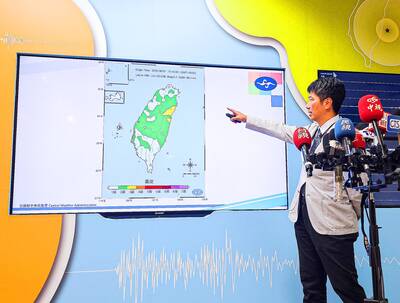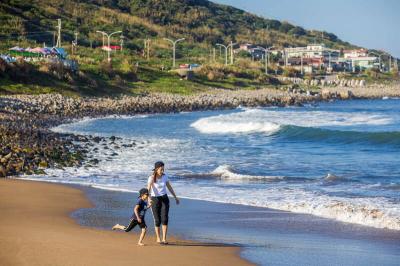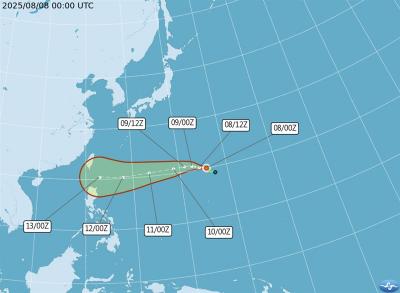Taipei Mayor Hau Lung-bin’s (郝龍斌) guarantee of the safety of the Maokong Gondola was challenged yesterday by Democratic Progressive Party (DPP) Taipei City councilors who cited geological reports to rebut the city government’s claim that support pillars are set into rocks beneath the surface.
Instead of “rocks,” what is beneath the surface of the gondola’s pillars is soft sandstone, and the city government was lying about the system’s safety, the councilors told a press conference at Taipei City Council.
“The city government has been telling the public that the pillars are set into hard rock and that there were no safety concerns. But the reports apparently told us another story. What lies underneath the surface are layers of sandstone and shale,” DPP Taipei City Councilor Chuang Ruei-hsiung (莊瑞雄) said.
Hau halted operations of the Maokong Gondola on Wednesday after a mudslide eroded the ground beneath a support pillar, but he insisted that the decision had only been taken to ease public anxiety.
Taipei City Secretariat Director Yang Hsi-an (楊錫安) said the pillars were set into igneous rock beneath the surface, so the stability of the pillars would not be affected if top soil eroded. Chuang and other DPP councilors presented two geology reports provided by China Engineering Consultants, the company asked by the Taipei City Government to analyze the geology of the area before the construction of the gondola system began. The reports showed that the components of subsoil were sandstone and shale.
“Where are the rocks? It’s all soft sand under the pillars. The city government is lying to us,” DPP Taipei City Councilor Hung Chien-yi (洪健益) said.
Yang said the layers of subsoil — from sandstone and shale to carbonate rock — have different levels of firmness. Subsoil that is 2m or deeper under the surface can be defined as “rock” in engineering terms.
The pillars are set more than 15m under the surface, and should be stable and safe, he said.
Shannon Lee (李咸亨), a civil engineering expert invited by the city government to evaluate the safety of the system, said after a municipal meeting yesterday that the civil engineering groups suggested steel posts be placed along the cliff to prevent rocks and soil from falling, and set up equipment to detect any moves of the stratum. The gondola system will not resume operations until the evaluation conducted by the groups of experts is completed and the groups have issued a report.
Meanwhile, National Taiwan University geography professor Lin Jiun-chuan (林俊全) said the debate between the Taipei City Council and the city government may have gotten off on the wrong foot.
“The foundation of the gondola station should be implanted into the sandstone level. There is no question about that as it appears to be the case with the station. However, the nature of sandstone levels vary widely,” he said.
Depending on the direction the sheets of rock are aligned, slopes can be either “dip slopes,” or “scarp slopes,” Lin said.
“While dip slopes have rock sheets pointing in the same direction as the slope and therefore are much more prone to landslides, scarp slopes have rock sheets that go against the slope and therefore are less likely to slide,” he said.
Investigations should be conducted to see which type of slope the system is built on, he said. If it turns out the system was built on a dip slope, Lin said that engineering and constructional techniques should be able to alleviate the problem.
Lin said he could not comment directly on the safety issue because he had not inspected the area.
ADDITIONAL REPORTING BY MEGGIE LU

Aftershocks from a magnitude 6.2 earthquake that struck off Yilan County at 3:45pm yesterday could reach a magnitude of 5 to 5.5, the Central Weather Administration (CWA) said. Seismological Center technical officer Chiu Chun-ta (邱俊達) told a news conference that the epicenter of the temblor was more than 100km from Taiwan. Although predicted to measure between magnitude 5 and 5.5, the aftershocks would reach an intensity of 1 on Taiwan’s 7-tier scale, which gauges the actual effect of an earthquake, he said. The earthquake lasted longer in Taipei because the city is in a basin, he said. The quake’s epicenter was about 128.9km east-southeast

GENSLER SURVEY: ‘Economic infrastructure is not enough. A city needs to inspire pride, offer moments of joy and foster a sense of belonging,’ the company said Taipei was named the city with the “highest staying power” in the world by US-based design and architecture firm Gensler. The Taiwanese capital earned the top spot among 65 cities across six continents with 64 percent of Taipei respondents in a survey of 33,000 people saying they wanted to stay in the city. Rounding out the top five were Vietnam’s Ho Chi Minh City (61 percent), Singapore (59 percent), Sydney (58 percent) and Berlin (51 percent). Sixth to 10th place went to Monterrey, Mexico; Munich, Germany; Sao Paulo, Brazil; Vancouver; and Seoul. Cities in the US were ranked separately, with Minneapolis first at

The New Taipei City Government today warned about the often-overlooked dangers of playing in water, and recommended safe swimming destinations to cool off from the summer heat. The following locations in the city as safe and fun for those looking to enjoy the water: Chienshuiwan (淺水灣), Baishawan (白沙灣), Jhongjiao Bay (中角灣), Fulong Beach Resort (福隆海水浴場) and Sansia District’s (三峽) Dabao River (大豹溪), New Taipei City Tourism and Travel Department Director-General Yang Tsung-min (楊宗珉) said. Outdoor bodies of water have variables outside of human control, such as changing currents, differing elevations and environmental hazards, all of which can lead to accidents, Yang said. Sudden

Tropical Storm Podul has formed over waters north-northeast of Guam and is expected to approach the seas southeast of Taiwan next week, the Central Weather Administration (CWA) said today. The 11th Pacific storm of the year developed at 2am over waters about 2,660km east of Oluanpi (歐鑾鼻), Pingtung County — Taiwan's southernmost tip. It is projected to move westward and could have its most significant impact on Taiwan on Wednesday and Thursday next week, the CWA said. The agency did not rule out the possibility of issuing a sea warning at that time. According to the CWA's latest update, Podul is drifting west-northwest